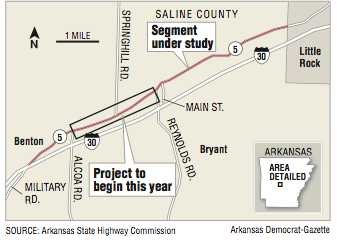An analysis of a section of Arkansas 5 in Saline County has concluded that upgrades worth up to $57 million are required to relieve congestion, increase safety and accommodate development along the busy corridor that parallels Interstate 30 and serves as a substitute route to the freeway.
Two alternatives developed by the Arkansas Highway and Transportation Department would widen the 7-mile section to four travel lanes. One alternative includes a raised median, while the other envisions a center left-turn lane. Both alternatives would include sidewalks and bicycle lanes.
The Arkansas Highway Commission on Friday adopted the agency study as a planning guide, but work on at least one section of the corridor could be contracted as soon as this year.
The recommendations to widen the highway between the Pulaski County line and I-30 in Benton come as the county is undergoing a road construction boom to catch up to its population -- which shot up nearly 10 percent, to 117,460, between 2010 and 2015, according to U.S. Census Bureau estimates.
Also Friday, the Highway Department confirmed that it has accepted a $6.7 million bid opened last month to build a second I-30 interchange in Bryant, where the population climbed 20 percent, to nearly 20,000, during the same period.
The city chipped in $2 million for the interchange.
That interchange will eventually tie in with the new Bryant Parkway from I-30 to Reynolds Road. The estimated $14 million cost of the interchange will be paid with proceeds from a bond extension city voters approved last year.
The Highway Department has set aside $12.6 million in its 2016-2020 statewide transportation improvement program for the first segment of the Arkansas 5 corridor to be widened, between Alcoa Road and Reynolds Road, which is also called Arkansas 183.
"I'm very pleased about all this," Bryant Mayor Jill Dabbs said Friday. "It's a combination of a lot of things coming together and the result of a lot of cooperation between a lot of agencies. All of the construction will give us a lot of [traffic] relief and open up more areas to economic development."
Work also is ramping up on a $78.5 million project to widen 17.6 miles of U.S. 70 to five lanes between I-30 in Saline County and Hot Springs in Garland County.
The Arkansas 5 study dates back eight years. At the request of local officials, the state Highway Commission approved the study in 2009 to identify improvements on the route that serves as an alternative to I-30 and provides access to employment and commerce in Saline and Pulaski counties, as well as the greater central Arkansas region.
Now consisting of two 10-foot or 11-foot travel lanes, traffic ranges from 6,300 vehicles per day south of Salem Road to 17,300 per day near Arkansas 183.
"I just couldn't believe the traffic," said Dick Trammel of Rogers, the commission chairman.
The study, anticipating the potential for additional development as well as the reasonable commuting distance to major employment centers in the Little Rock area, projects the traffic on some sections of the highway will climb to more than 30,000 vehicles per day by 2036.
The study also found that crash rates, particularly those involving fatalities or serious injuries, exceed the statewide average for undivided two-lane urban roads.
A section of the highway covering 1.59 miles from just west of Springhill Road to Main Street in Bryant averaged 56.2 crashes annually in the period the study covered, from 2010 to 2014. That equated to a crash rate of 7.22 crashes per million vehicle miles traveled, or more than 2.5 times the statewide average of 2.64 on the same type of road.
The rate of crashes involving deaths or serious injuries was also high, coming in at 15.56 per 100 million vehicle miles traveled, or 1.4 times the statewide average of 10.86.
Without improvements, the study said, the route would see "excessive queuing and near gridlock conditions" and "serve poorly as an alternate route when travel on Interstate 30 is disrupted."
The section between Alcoa and Reynolds roads has been designed with four travel lanes and a continuous center left-turn lane, said Mike Fugett, the department's assistant chief engineer for design.
Scott Bennett, the department director, said the design of the other sections hasn't been decided.
The total cost of the raised-median alternative is $55.2 million, which includes $41.8 million for construction. The total cost for the turn-lane alternative is $57.4 million of which $43.5 million is for construction. The total costs also include engineering, buying rights of way and relocating utilities.
A Section on 02/11/2017
